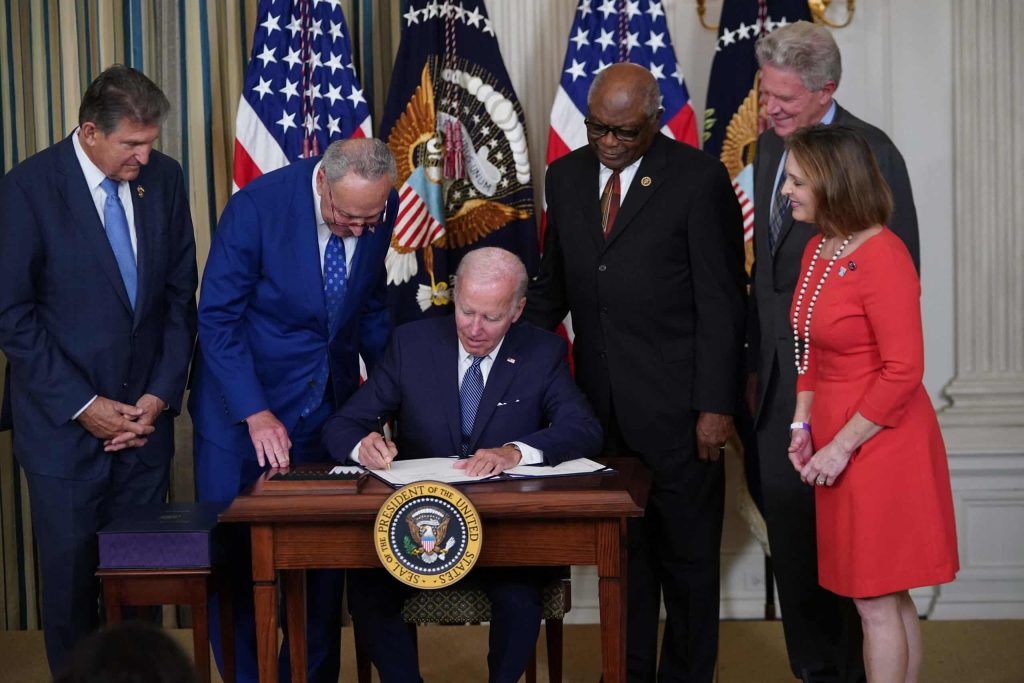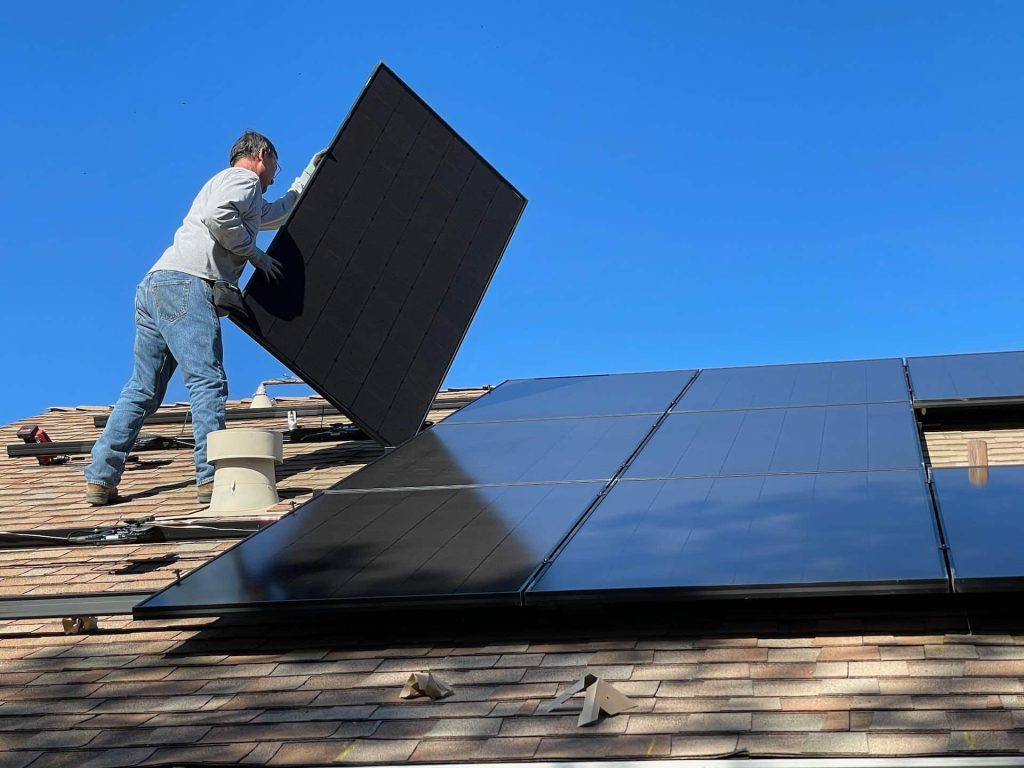On 16 August 2022, US President Joe Biden signed the US Inflation Reduction Act (IRA). The programme is intended to “reduce costs for families, combat the global climate crisis, and ultimately ask the largest corporations to pay their fair share”, as the White House page informs us. In the area of green energy, the main aim is to reduce energy costs. For example, families taking advantage of tax incentives for green energy and e-vehicles can save around USD 1,000 per year. This means rebates for
- the purchase of heat pumps (direct rebates of USD 14,000 USD)
- rooftop solar installations (30% tax credits)
- the purchase of e-vehicles (tax credits of USD 7,500).
The goal is to reduce CO2 emissions in the USA by 40% by the year 2030.
Billions of investments
In total, the investments in energy transition are estimated to amount to about USD 369bn. However, this estimate could be on the conservative side. According to research by Credit Suisse, the investment volume could be twice as high and amount to about USD 800bn, given that the incentives for e-vehicles and green energy are to be understood as uncapped. This means that as long as the conditions for receiving the incentives are met, taxpayers can claim them. Thus, no budget or cap was set for the incentive scheme. The current estimate of how often these incentive schemes could be used could therefore definitely be lowballing reality. In addition, these incentives could be expected to also promote private investments. This would allow for a total investment volume in climate solutions of around USD 1.7trn over the next ten years.

Source: MANDEL NGAN / AFP / picturedesk.com
The political environment
Since the Inflation Reduction Act was passed, we have seen a lot of discussion about the specific clauses and the future of the Act. For example, there are various assumptions at play about how the Republican side will support or obstruct the Act in the next few years, and particularly until the next presidential elections. According to a Bloomberg report by Brian Eckhouse, individual Republicans, for example, have consistently supported wind energy in recent years. Overall, however, support for green technologies from the Republican side would be limited, as not a single Republican member of Congress supported the new Climate Change Act.
According to Alex McDonough, who is a partner at Pioneer Public Affairs and lobbied for various parts of the IRA, the Republican side might try to delay the implementation of the Act. The longer the enforcement of individual parts is delayed, the more room there is to find and spread arguments against the implementation.
Incentive systems hold opportunities for various industries
However, McDonough points out that a unanimous rejection of the bill by the Republicans is not overly likely. After all, various Republican interests, such as the promotion of nuclear energy or carbon capture technologies, have also found their way into the Act. The danger of a split on the Republican side would be too great if a unanimous rejection were to be pushed through.
According to McDonough, the main arguments underlining the popularity of the Act, which are also recognised on the Republican side, are the expansion of production and the creation of numerous new jobs. The incentive systems and programmes stipulated in the Act are also extremely broad-based and therefore bring opportunities for a wide range of industries. Large-scale wind and solar projects would benefit, as would carbon capture technologies or hydrogen (which is in demand from several different industries). Tax incentives for nuclear reactors and subsidies for hydropower also benefit important sectors. Finally, the “financing question” was settled the moment the law was passed, and future allocations were no longer necessary, as McDonough summarises for UtilityDive.
The hope for green jobs
The situation seems particularly hopeful given the large number of new jobs being created in the renewables sector. According to a Bloomberg report by Brian Eckhouse, around USD 25.7bn will be invested in new factories based on renewable energies in the USA – partly due to the generous funds provided by the IRA funding pot. More conservative states such as Georgia would welcome these new jobs, even though these were viewed in a different context until recently. “Global warming and CO2 are actually healthy for us,” said Congresswoman Taylor Greene in the community of Dalton, Georgia. Green energy has not played a role here worth mentioning until now. Timothy Fox of Clear View Energy Partners regards the new solar panel production plant to be built in Dalton as a political game changer. Due to the newly created jobs, the different views on renewable energies based on party affiliation could speak with one voice in the future.

Photo: (c) unsplash
Other Georgia municipalities are also benefiting. According to Republican Governor Brian Kemp’s website, a new battery manufacturing plant is to be built in Coweta by FREYR Battery. It is valued at about USD 2.57bn and is expected to bring 723 new green jobs to the region. “Innovation-driven companies from around the world are choosing to locate in Georgia because they believe they can succeed here. We warmly welcome FREYR to bring transformative investments and opportunities to our communities,” says the website. FREYR’s new plant will be located at an industrial park and will recruit personnel for a variety of fields, including engineers, technicians, operational personnel, as well as administrative and managerial positions. The plant is being evaluated as we speak for renewable energy supply through solar installations.
New locations planned in the USA
According to Governor Kemp, investments of USD 13bn and 19,000 new jobs in the field of e-mobility can be expected in Georgia alone. Permits for around 30 new projects have been applied for in recent years, among them a planned USD 5.5bn Hyundai plant in Savannah to produce electric vehicles, as Reuters reported. Production has been set to launch in the first half of 2025 and annual production capacity is expected at around 300,000 vehicles. The new plant is part of the company’s commitment to invest USD 10bn in future mobility by 2025. Other companies interested in locations in the United States include Honda Motor and LG Energy, which are planning to build a USD 4.4bn battery production plant in Ohio, according to Bloomberg. In other, actually conservative states, there is also great interest in attracting new production facilities for renewable energies. Potential investors are being wooed, for example, with even more tax breaks, site redevelopment or infrastructure improvements. These developments are in line with the IRA and the president’s hope to revitalise cities through the Climate Change Act and at the same time fight global warming.
Parts of the IRA that relate to e-vehicles, for example, remain controversial. According to Reuters, incentives for such vehicles may only be obtained if they are assembled in the USA. This restriction would disqualify about 70% of e-vehicles from the incentive system. Negotiations in this context, including with the EU, are ongoing.
This article is part of the ESGenius Letter on the topic of the Energy of the Future. The other articles with information and insights on sustainable energy use can be found here.
For a glossary of technical terms, please visit this link: Fund Glossary | Erste Asset Management
Legal note:
Prognoses are no reliable indicator for future performance.
Legal disclaimer
This document is an advertisement. Unless indicated otherwise, source: Erste Asset Management GmbH. The language of communication of the sales offices is German and the languages of communication of the Management Company also include English.
The prospectus for UCITS funds (including any amendments) is prepared and published in accordance with the provisions of the InvFG 2011 as amended. Information for Investors pursuant to § 21 AIFMG is prepared for the alternative investment funds (AIF) administered by Erste Asset Management GmbH pursuant to the provisions of the AIFMG in conjunction with the InvFG 2011.
The currently valid versions of the prospectus, the Information for Investors pursuant to § 21 AIFMG, and the key information document can be found on the website www.erste-am.com under “Mandatory publications” and can be obtained free of charge by interested investors at the offices of the Management Company and at the offices of the depositary bank. The exact date of the most recent publication of the prospectus, the languages in which the fund prospectus or the Information for Investors pursuant to Art 21 AIFMG and the key information document are available, and any other locations where the documents can be obtained are indicated on the website www.erste-am.com. A summary of the investor rights is available in German and English on the website www.erste-am.com/investor-rights and can also be obtained from the Management Company.
The Management Company can decide to suspend the provisions it has taken for the sale of unit certificates in other countries in accordance with the regulatory requirements.
Note: You are about to purchase a product that may be difficult to understand. We recommend that you read the indicated fund documents before making an investment decision. In addition to the locations listed above, you can obtain these documents free of charge at the offices of the referring Sparkassen bank and the offices of Erste Bank der oesterreichischen Sparkassen AG. You can also access these documents electronically at www.erste-am.com.
Our analyses and conclusions are general in nature and do not take into account the individual characteristics of our investors in terms of earnings, taxation, experience and knowledge, investment objective, financial position, capacity for loss, and risk tolerance. Past performance is not a reliable indicator of the future performance of a fund.
Please note: Investments in securities entail risks in addition to the opportunities presented here. The value of units and their earnings can rise and fall. Changes in exchange rates can also have a positive or negative effect on the value of an investment. For this reason, you may receive less than your originally invested amount when you redeem your units. Persons who are interested in purchasing units in investment funds are advised to read the current fund prospectus(es) and the Information for Investors pursuant to § 21 AIFMG, especially the risk notices they contain, before making an investment decision. If the fund currency is different than the investor’s home currency, changes in the relevant exchange rate can positively or negatively influence the value of the investment and the amount of the costs associated with the fund in the home currency.
We are not permitted to directly or indirectly offer, sell, transfer, or deliver this financial product to natural or legal persons whose place of residence or domicile is located in a country where this is legally prohibited. In this case, we may not provide any product information, either.
Please consult the corresponding information in the fund prospectus and the Information for Investors pursuant to § 21 AIFMG for restrictions on the sale of the fund to American or Russian citizens.
It is expressly noted that this communication does not provide any investment recommendations, but only expresses our current market assessment. Thus, this communication is not a substitute for investment advice.
This document does not represent a sales activity of the Management Company and therefore may not be construed as an offer for the purchase or sale of financial or investment instruments.
Erste Asset Management GmbH is affiliated with the Erste Bank and austrian Sparkassen banks.
Please also read the “Information about us and our securities services” published by your bank.

